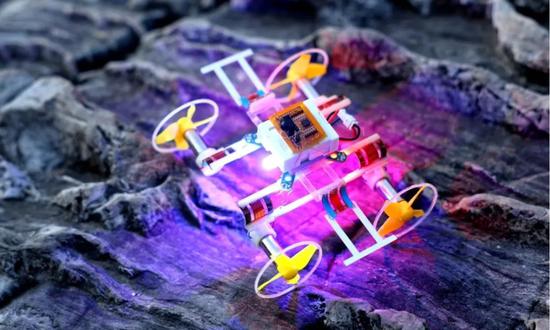Chinese scientists create a 9-cm untethered terrestrial-aerial microrobot capable of transforming into various desired shapes

A 9-centimeter untethered terrestrial-aerial microrobot capable of shape-shifting, developed by a research team at Tsinghua University (Photo/Courtesy of the research team)
A Chinese research team has developed the world's smallest and lightest known untethered terrestrial-aerial microrobot capable of transforming into various desired shapes, expected to replace humans in performing a wide range of tasks in complex and hazardous environments.
The robot measuring 9 centimeters in length and 25 grams in weight can operate flexibly on land and in the air with a top speed of up to 1.6 meters per second on the ground, according to the research team from Tsinghua University.
The research team has recently developed a thin-film-shaped small-scale actuator that enables microrobots to continuously transform their shape and "lock" into specific configurations - much like a Transformer - enhancing their ability to adapt to different environments.
The actuator is a device with controllable shape-morphing capability and serves as the "heart" of a microrobot.
Using this actuator along with a Lego-inspired design strategy they developed, the researchers created the world's smallest and lightest untethered terrestrial-aerial microrobot in the literature.
The robot consists of several components, including actuators, rotors, motors, control modules, and a lithium battery, Zhang Yihui, a professor from the School of Aerospace Engineering and the State Key Laboratory of Flexible Electronics Technology of Tsinghua University who led the research team, told the Global Times on Sunday.
Zhang explained that the actuator featuring controllable shape morphing allows the rotors to transform into wheels when the robot lands on the ground.
The team noted that enabling robots to walk, run, jump, fly, climb, and lock into any shape at any time is critical for expanding their application scenarios. It is reported that current small-scale actuators under five centimeters in size generally struggle to achieve both continuous shape morphing and locking, which has severely limited the miniaturization and untethered control of multimodal robots.
Based on innovations in the synergistic material-structure design, the research team has independently developed the miniature actuator as small as a few millimeters in size. Acting as a "morphable exoskeleton," it can integrate functional components like sensors and motors, enabling the creation of complex robotic systems.
Zhang noted that developing a robot that is compact, lightweight, wirelessly controlled, and capable of complex shape morphing is extremely difficult. The new actuator features excellent shape morphing and locking capability. It can be electrically controlled to continuously deform into any desired shape and then "lock" the deformed configuration - something that was difficult to achieve with previous small-scale actuators.
The untethered terrestrial-aerial microrobot assembled with the actuator can run and fly through shape transformations, demonstrating agile movements.
Additionally, the team also used more than 10 actuators to create a miniature "Transformer" actuator that stands 4.5 centimeters tall and weighs only 0.8 grams.
Zhang said the research offers new ideas and routes to the development of miniature robots. In the future, such untethered terrestrial-aerial microrobots could be used in scenarios such as equipment fault diagnosis and maintenance, as well as geological and cultural relic exploration, potentially replacing humans in complex and hazardous environments.
The miniature actuator can also be used in bioelectronic devices, enabling the development of deployable implantable medical devices and haptic feedback interfaces for virtual reality (VR) and augmented reality (AR) applications.
Zhang explained that due to its controllable deformation, the miniature actuator can be applied in the development of vascular stents which can open up areas in the blood vessel when placed inside it and allow better blood flow.
The research was published in the peer-reviewed international scientific journal Nature Machine Intelligence on Friday evening (Beijing time).
